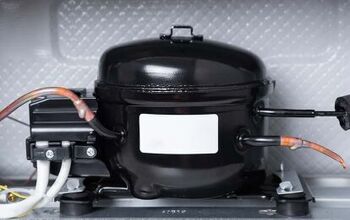Kenmore Elite Refrigerator Not Cooling? (Possible Causes & Fixes)

Kenmore is just one of many manufacturers of kitchen appliances across North America. Their line of refrigerators is some of the most well-known on the market today and has become a favorite for consumers everywhere.
Sometimes, the fridge can stop working and there are a number of potential issues involved. When your Kenmore Elite stops working, check the evaporator fan motor, the condenser fan motor, condenser coils, the start relay, or something else. Working through the potential issues to find the culprit is key.
Do You Need Appliance Repair Services?
Get free, zero-commitment quotes from pro contractors near you.

Why is My Kenmore Elite Refrigerator Not Cooling?
When it comes to refrigerators, there are too many components to simply jump to conclusions right away. There are certain signs to be aware of that can make issues known, but it will take a little sleuthing to narrow things down.
Not only that, but the culprit will dictate the solution. Certain components in your fridge can simply be replaced and done so cheaply. Others are very costly and will leave you seriously questioning whether or not an entirely new fridge is worth it. This guide will take you through the potential culprits and help you to understand what to do in each of those situations.
Condenser Fan Motor
The purpose of the condenser fan motor is to draw air in via the condenser coils and then over the compressor itself. When the condenser fan motor isn’t working the way that it is supposed to, it is one of the reasons that your Kenmore Elite refrigerator won’t cool.
1. Check the condenser fan. The good news is that you can check on the fan blade to look for potential obstructions.
2. Turn the fan motor blade. Should you find no obstructions, you can try to turn the fan motor blade carefully by hand. If it doesn’t spin easily and freely, you will need to replace your condenser fan motor entirely.
3. Use a multimeter. If there aren’t any obstructions and the fan blade turns easily, you will need to use a multimeter to test the continuity of the fan motor. Should you get this far, there is likely no continuity in the fan motor, meaning that you will need to replace it.
Dirty Condenser Coils
The condenser coils work by dissipating heat when the refrigerant passes through them. You can find the condenser coils as they are generally accessible underneath the refrigerator. When the coils become clogged or dirty, they aren’t able to dissipate that heat effectively.
The more the debris builds, the less efficient your refrigerator will be. This makes the fridge work all the more to cool down the interior of your fridge and can eventually burn out the compressor. When the compressor fails, you will have to ask yourself the very real question of whether or not to replace the fridge entirely.
1. Check the coils. If your fridge is struggling to get to the proper temperature and maintain it, check the coils first.
2. Clean or replace the coils. When the condenser coils are dirty, you can typically just clean them and you’ll get the fridge working properly once again.
Start Relay
The start relay works in tandem with the refrigerator’s start winding in order to jump the compressor. When your start relay is defective, the compressor may sometimes fail to start if it does at all. All of this comes together to result in a fridge that fails to cool properly.
1. Test the continuity. If you think that the start relay could be defective, you will need to use a multimeter to test the continuity between the start and run terminal sockets. Should the start relay not show any continuity between these two sockets, you will have to replace it.
2. Burning odors. Another way to tell if the start relay is bad is if it produces a burnt odor. If you smell a burnt odor coming from your fridge, there is a good chance that the start relay has gone bad and will need to be replaced.
Evaporator Fan Motor
The purpose of the evaporator fan motor is to draw air over the cooling coils and then circulate that throughout the freezer and fridge components. Depending on the model of your fridge, it could have more than one evaporator fan motor to it.
1. Inspect the evaporator fan motor. For fridges that have just one evaporator, you would find it in the freezer. When that evaporator fan isn’t working properly, the cold air won’t circulate into the refrigerator component. The freezer could get cold, however, so you will need to determine if the evaporator coil has gone bad.
2. Turn by hand. To test your evaporator fan motor, turn the fan blade by hand. If the blade doesn’t turn easily or freely, you will need to replace the evaporator fan motor entirely. Even if it runs, it could generate a noise that is unusually loud. When this is the case, replace the unit.
3. Test with a multimeter. Lastly, if the motor doesn’t run altogether, you will need to use a multimeter in order to test for continuity in the motor windings. If they show no continuity, replacing the evaporator fan motor is the only solution.
Start Capacitor
In the Kenmore Elite series of refrigerators, the start capacitor is what gives a boost of power to the compressor during the process of start-up. When the start capacitor isn’t working correctly, the compressor may not start altogether. And when the compressor doesn’t work, the fridge won’t cool at all.
If you think that the start capacitor is potentially defective, you will need to use a multimeter to test it. Should the start capacitor prove to be defective, you will have to replace it otherwise the compressor won’t kick on and cool the refrigerator component.
Temperature Control Thermostat
This component is what directs the necessary voltage to the evaporator fan motor, the compressor, and the condenser fan motor. When the temperature control thermostat isn’t working effectively, it can prevent the fridge’s refrigerant system from kicking on.
1. Rotate the thermostat. To check to see if your thermostat is ineffective or defective, you will need to rotate the thermostat to move it from the lowest setting up to the highest one.
2. Listen carefully. Listen carefully for a click during this process. If you hear that click, the thermostat is probably fine. If there is no click, break out the multimeter to check your thermostat for continuity.
3. Replace. Should the temperature control thermostat not have continuity on any of the settings, replace it immediately.
Compressor
The compressor in your refrigerator is the pump that compresses the refrigerant and then distributes it throughout the condenser coils and evaporator. When the compressor doesn’t work correctly, you can guarantee that the fridge won’t cool.
The thing about the compressor is that it is typically another issue at hand. Before you consider replacing the compressor, check the other components first. Not only are those likely to be more defective, but they will be cheaper and easier to replace.
Check with a multimeter. If you have checked out all of the other components and still can’t come to a resolution, the compressor is likely at fault. Having a multimeter handy to check the continuity of the various components is extremely handy. Test the continuity between the electrical pins located on the side of the compressor.
Check the open circuit. Should there be an open circuit, your compressor is likely defective. And when the compressor is defective, there is no repairing it or replacing it yourself. Have a licensed technician come out to perform the repairs or replace the fridge entirely depending on your budget and needs.
Temperature Control Board
In your fridge, the temperature control board is what provides the necessary voltage to the fan motors and compressor. When the temperature control board turns defective, it won’t send that necessary voltage into the cooling system.
This isn’t a common occurrence though. More often than not, the control board is misdiagnosed. So, before you go replacing it, make sure that you check out the more common problem components first. If none of them turn up defective, circle back around to check out the temperature control board and consider replacement.
Thermistor
One of the final potential issues with your Kenmore Elite refrigerator could be the thermistor. The thermistor is what monitors the temperature in your fridge and then sends that reading back to the control board. The temperature control board then regulates the power that goes into the evaporator fan and compressor based on those readings.
When the thermistor is defective, the evaporator fan and compressor may not run when they need to and the fridge won’t be able to cool itself down properly.
Test using a multimeter. Like anything else on this list, you can test the continuity of the thermistor using a multimeter. The thermistor resistance should change as the fridge’s temperature does. If there is no change in the thermistor resistance or there is no continuity, you will have to replace the thermistor entirely.
Main Control Board
Lastly is the main control board. Of all the likely causes on the list, the main control board is the least likely to fail. You should troubleshoot all of the other probable causes on the list before moving on to the main control board.
It may take some time but testing the continuity of the other components first will let you know whether or not the main control board is defective. If you determine that all of the other components are working fine, you may have to replace the main control board.
Do You Need Appliance Repair Services?
Get free, zero-commitment quotes from pro contractors near you.

Finding a Malfunctioning Fridge
Determining the cause of a malfunctioning fridge can take a little bit of time and effort but eliminating the most probable causes will help you to find the real culprit. Aside from the main control board and the compressor, the others are fairly affordable and easy to replace even on your own. When it gets to those other components, you may have to make the tough decision about whether to replace those components or just get a new fridge entirely.

Ryan Womeldorf has more than a decade of experience writing. He loves to blog about construction, plumbing, and other home topics. Ryan also loves hockey and a lifelong Buffalo sports fan.
More by Ryan Womeldorf















![How To Reset A Whirlpool Cabrio Washer [In 5 Easy Steps!]](https://cdn-fastly.upgradedhome.com/media/2023/07/31/9076531/how-to-reset-a-whirlpool-cabrio-washer-in-5-easy-steps.jpg?size=350x220)











